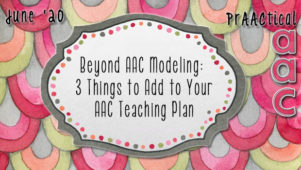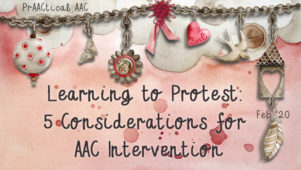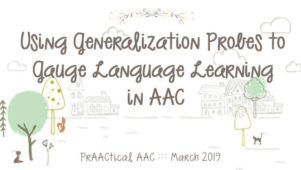5 Ways to Promote Generalization of AAC Use

Do you work with AAC learners who demonstrate their communication skills in therapy or instructional lessons, but not elsewhere? In this post, we review some things we can do to make it easier for AAC learners to generalize their newly-developed skills and use them in a variety of places with a range of communication partners.
Part of the solution to this problem lies in collaborating with the communication partners in other settings. In doing that, we want to be sure that the partners use good communication facilitation strategies, such as these. Partner skills are something we’ve covered here on several occasions.
Today, we’ll focus on changes we can make within our direct intervention or instructional lessons with AAC learners. Initially, we may control some of the instructional variables, such as materials and cues, rather tightly. Keeping things consistent is great for the initial teaching of new skills because it allows them to focus on the key aspects of the new skill. As the AAC learner begins to get the hang of it, though, it can be helpful to loosen the reins.
Many times, our AAC learners acquire a new skill but use it quite inconsistently for a few weeks or months. It depends on the individual and the complexity of the skill, but this is a normal part of the learning process and is nothing to be concerned about. We all do things inconsistently when we are still learning. Remember learning how to cite research articles in your college days? Chances are that even after you learned the correct format, you made lots of mistakes in the papers you wrote. Applying new knowledge and skills doesn’t happen all at once.
So, what can we do to make it more likely that AAC skills are used in flexible ways? Once learners are at the emerging level, we might want to change things up a bit to make it easier for them to use these skills outside of the therapy/teaching environment. Here are some things to consider in planning your therapy/instruction.
- Switch up the learning materials: If you stick with the same toys, games, activities, or curriculum materials every time you teach and practice the new skill, the AAC learner doesn’t get to see how this skill is used with other things. Instead, we can have a number of different sets of materials that we use and rotate them throughout our therapy sessions. That way, the new skill isn’t associated exclusively with one set of materials or one particular activity.
- Use different verbiage: When trying to elicit the target behavior, try varying the set up so that you are not using the exact same wording each time. That teaches the AAC learner to use the new skill in response to several different learning contexts. When Jonah was learning to make requests at snack time, his teacher varied the way she presented the context. “You look hungry.” “Tell me what you want.” “Look what I have.” “You can ask for some.” That way, Jonah didn’t become dependent on one particular manner of presentation. He was able to generalize his requesting skills to a whole bunch of ways that his teacher presented the opportunities.
- Use a variety of communication partners: If we want AAC learners to communicate with lots of different people, we need to start introducing that in therapy/instructional lessons. Recruit a colleague, staff member, or peer to participate, even for a few minutes, so that the learner has supported opportunities to use their new AAC skills with others.
- Vary the location of the teaching: Another way we can help AAC learners generalize skills to functional settings is to vary the site of instruction. We can practice commenting in our therapy room, but also in the corridor, in the classroom reading corner, at the computer station, in the free play area, etc. By moving to other locations, we help the AAC learner develop the habit of using new skills in those places.
- Vary the communicative context: It’s important that our AAC learners recognize when to use their new skills. If I only tempt a longer utterance with ‘Tell me more,’ then the AAC learners won’t necessarily expand their sentences without that sort of cue. Instead, we might use that some of the time but also create communicative contexts in which a longer pause or exaggerated facial expression and questioning body posture is used. The student learns to read these signals and use the new skill of adding more information to help his/her partner better understand the intent of the message.
Generalizing AAC skills to daily living situations at home, in school, and in the community is the Brass Ring, and there are lots of things we can do to help our clients reach up and grab it. You can read more about this topic here and here. Do you have favorite ways of helping AAC learners use their new communication skills in un-trained situations? We’d love to hear about them.
Filed under: Featured Posts, PrAACtical Thinking
Tagged With: AAC intervention, generalization, loose training
This post was written by Carole Zangari




